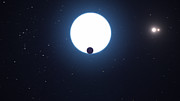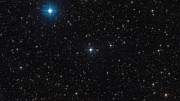Artist’s impression of planet in the HD 131399 system
Artist’s impression of planet in the HD 131399 system
PR Image eso1624c
The orbits of the planet and stars in the HD 131399 system
PR Image eso1624d
SPHERE observations of the planet HD 131399Ab
The sky around the triple-star system HD 131399
The triple star HD 131399 in the constellation of Centaurus (The Centaur)
SPHERE observations of the planet HD 131399Ab
Videos

Artist’s impression of planet orbiting in the HD 131399 system
Zooming in on the HD 131399 triple-star system
A team of astronomers have used the
SPHERE instrument on ESO’s Very Large Telescope to image the first
planet ever found in a wide orbit inside a triple-star system. The orbit
of such a planet had been expected to be unstable, probably resulting
in the planet being quickly ejected from the system. But somehow this
one survives. This unexpected observation suggests that such systems may
actually be more common than previously thought. The results will be
published online in the journal Science on 7 July 2016.
Luke Skywalker's home planet, Tatooine, in the Star Wars
saga, was a strange world with two suns in the sky, but astronomers
have now found a planet in an even more exotic system, where an observer
would either experience constant daylight or enjoy triple sunrises and
sunsets each day, depending on the seasons, which last longer than human
lifetimes.
This world has been discovered by a team of astronomers led by the University of Arizona, USA, using direct imaging at ESO’s Very Large Telescope (VLT) in Chile. The planet, HD 131399Ab [1],
is unlike any other known world — its orbit around the brightest of the
three stars is by far the widest known within a multi-star system. Such
orbits are often unstable, because of the complex and changing
gravitational attraction from the other two stars in the system, and
planets in stable orbits were thought to be very unlikely.
Located about 320 light-years from Earth in the constellation of Centaurus
(The Centaur), HD 131399Ab is about 16 million years old, making it
also one of the youngest exoplanets discovered to date, and one of very
few directly imaged planets. With a temperature of around 580 degrees
Celsius and an estimated mass of four Jupiter masses, it is also one of
the coldest and least massive directly-imaged exoplanets.
"HD 131399Ab is one of the few exoplanets that have been directly
imaged, and it's the first one in such an interesting dynamical
configuration," said Daniel Apai, from the University of Arizona, USA, and one of the co-authors of the new paper.
"For about half of the planet’s orbit, which lasts 550
Earth-years, three stars are visible in the sky; the fainter two are
always much closer together, and change in apparent separation from the
brightest star throughout the year," adds Kevin Wagner, the paper's first author and discoverer of HD 131399Ab [2].
Kevin Wagner, who is a PhD student at the University of Arizona,
identified the planet among hundreds of candidate planets and led the
follow-up observations to verify its nature.
The planet also marks the first discovery of an exoplanet made with the SPHERE
instrument on the VLT. SPHERE is sensitive to infrared light, allowing
it to detect the heat signatures of young planets, along with
sophisticated features correcting for atmospheric disturbances and
blocking out the otherwise blinding light of their host stars.
Although repeated and long-term observations will be needed to
precisely determine the planet's trajectory among its host stars,
observations and simulations seem to suggest the following scenario: the
brightest star is estimated to be eighty percent more massive than the
Sun and dubbed HD 131399A, which itself is orbited by the less massive
stars, B and C, at about 300 au (one au, or astronomical unit, equals
the average distance between the Earth and the Sun). All the while, B
and C twirl around each other like a spinning dumbbell, separated by a
distance roughly equal to that between the Sun and Saturn (10 au).
In this scenario, planet HD 131399Ab travels around the star A in an
orbit with a radius of about 80 au, about twice as large as Pluto’s in
the Solar System, and brings the planet to about one third of the
separation between star A and the B/C star pair. The authors point out
that a range of orbital scenarios is possible, and the verdict on the
long-term stability of the system will have to wait for planned
follow-up observations that will better constrain the planet’s orbit.
"If the planet was further away from the most massive star in the system, it would be kicked out of the system," Apai explained. "Our
computer simulations have shown that this type of orbit can be stable,
but if you change things around just a little bit, it can become
unstable very quickly."
Planets in multi-star systems are of special interest to astronomers
and planetary scientists because they provide an example of how the
mechanism of planetary formation functions in these more extreme
scenarios. While multi-star systems seem exotic to us in our orbit
around our solitary star, multi-star systems are in fact just as common
as single stars.
"It is not clear how this planet ended up on its wide orbit in
this extreme system, and we can't say yet what this means for our
broader understanding of the types of planetary systems, but it shows
that there is more variety out there than many would have deemed
possible," concludes Kevin Wagner. "What we do know is that
planets in multi-star systems have been studied far less often, but are
potentially just as numerous as planets in single-star systems."
Notes
[1] The three components
of the triple star are named HD 131399A, HD 131399B and HD 131399C
respectively, in decreasing order of brightness. The planet orbits the
brightest star and hence is named HD 131399Ab.
[2] For much of the planet’s year the
stars would appear close together in the sky, giving it a familiar
night-side and day-side with a unique triple sunset and sunrise each
day. As the planet moves along its orbit the stars grow further apart
each day, until they reach a point where the setting of one coincides
with the rising of the other — at which point the planet is in
near-constant daytime for about one-quarter of its orbit, or roughly 140
Earth-years.
More Information
This research was presented in a paper
entitled “Direct Imaging Discovery of a Jovian Exoplanet Within a Triple
Star System”, by K. Wagner et al., to appear online in the journal Science on 7 July 2016.
The team is composed of Kevin Wagner (Steward Observatory, The University of Arizona, Tucson, Arizona, USA), Dániel Apai (Steward Observatory and Lunar and Planetary Laboratory, The University of Arizona, Tucson, Arizona, USA), Markus Kasper (ESO, Garching, Germany), Kaitlin Kratter (Steward Observatory, The University of Arizona, Tucson, Arizona, USA), Melissa McClure (ESO, Garching, Germany), Massimo Robberto (Space Telescope Science Institute, Baltimore, Maryland, USA) and Jean-Luc Beuzit (Université Grenoble Alpes, Institut de Planétologie et d’Astrophysique de Grenoble, Grenoble, France; Centre National de la Recherche Scientifique, Institut de Planétologie et d’Astrophysique de Grenoble, Grenoble, France).
ESO is the foremost intergovernmental astronomy organisation in
Europe and the world’s most productive ground-based astronomical
observatory by far. It is supported by 16 countries: Austria, Belgium,
Brazil, the Czech Republic, Denmark, France, Finland, Germany, Italy,
the Netherlands, Poland, Portugal, Spain, Sweden, Switzerland and the
United Kingdom, along with the host state of Chile. ESO carries out an
ambitious programme focused on the design, construction and operation of
powerful ground-based observing facilities enabling astronomers to make
important scientific discoveries. ESO also plays a leading role in
promoting and organising cooperation in astronomical research. ESO
operates three unique world-class observing sites in Chile: La Silla,
Paranal and Chajnantor. At Paranal, ESO operates the Very Large
Telescope, the world’s most advanced visible-light astronomical
observatory and two survey telescopes. VISTA works in the infrared and
is the world’s largest survey telescope and the VLT Survey Telescope is
the largest telescope designed to exclusively survey the skies in
visible light. ESO is a major partner in ALMA, the largest astronomical
project in existence. And on Cerro Armazones, close to Paranal, ESO is
building the 39-metre European Extremely Large Telescope, the E-ELT,
which will become “the world’s biggest eye on the sky”.
Links
Contacts
Kevin Wagner
Steward Observatory, The University of Arizona
Tucson, USA
Tel: 00 1 (859) 609-3611
Markus Kasper
ESO
Garching bei München, Germany
Tel: +49 89 3200 6359
Email: mkasper@eso.org
Daniel Apai
Steward Observatory, The University of Arizona
Tucson, USA
Email: apai@email.arizona.edu
Richard Hook
Public Information Officer, ESO
Garching bei München, Germany
Tel: +49 89 3200 6655
Cell: +49 151 1537 3591
Source: ESO







